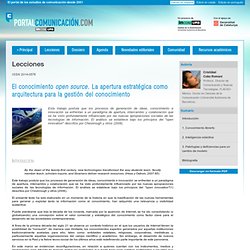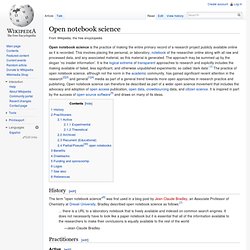

Lecciones · El conocimiento <i>open source</i>. La apertura estratégica como arquitectura para la gestión del conocimiento. By the dawn of the twenty-first century, new technologies transformed the way students learn, faculty member teach, scholars inquire, and librarians deliver research resources.

Sciverse Hub. Making Science Visible. Science. The more we understand about science and its complexities, the more important it is for scientific data to be shared openly.

It’s not useful to have ten different labs doing the same research and not sharing their results; likewise, we’re much more likely to be able to pinpoint diseases if we have genomic data from a large pool of individuals. Since 2004, we’ve been focusing our efforts to expand the use of Creative Commons licenses to scientific and technical research. Science Advisory Board Open Access The Scholars’ Copyright Project Creative Commons plays an instrumental role in the Open Access movement, which is making scholarly research and journals more widely available on the Web. We’re also expanding Open Access to research institutions. We’ve created policy briefings and guidelines to help institutions implement Open Access into their frameworks. Science Commons. (For even more information on our history and organizational structure, click here.)

There are petabytes of research data being produced in laboratories around the world, but the best web search tools available can’t help us make sense of it. Why? Because more stands between basic research and meaningful discovery than the problem of search. Many scientists today work in relative isolation, left to follow blind alleys and duplicate existing research. Data are fragmented — trapped behind firewalls, locked up by contracts or lost in databases that can’t be accessed or integrated. The consequences in many cases are no less than tragic.
Science Commons has three interlocking initiatives designed to accelerate the research cycle — the continuous production and reuse of knowledge that is at the heart of the scientific method. Making scientific research “re-useful” — We help people and organizations open and mark their research and data for reuse. Research for Development - Home. CROWDFUNDING THE COMMONS. Academic Video Lectures. OER Commons. Open Notebook Science. History[edit] The term "open notebook science"[6] was first used in a blog post by Jean-Claude Bradley, an Associate Professor of Chemistry at Drexel University.

Bradley described open notebook science as follows:[7] ... there is a URL to a laboratory notebook that is freely available and indexed on common search engines. It does not necessarily have to look like a paper notebook but it is essential that all of the information available to the researchers to make their conclusions is equally available to the rest of the world—Jean-Claude Bradley Practitioners[edit] Active[edit] Experimental[edit] Jean-Claude Bradley[8]Andrew S.I.D. Theoretical[edit] Tobias J. Archived[edit] Recurrent (Educational)[edit] Junior Physics Lab (307L) at University of New Mexico[29] Partial/Pseudo[30] open notebooks[edit] These are initiatives more open than traditional laboratory notebooks but lacking a key component for full Open Notebook Science.